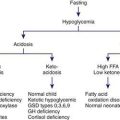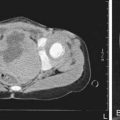Chapter 357 Cystic Diseases of the Biliary Tract and Liver
Cystic lesions of liver may be initially recognized during infancy and childhood (see ![]() Table 357-1 on the Nelson Textbook of Pediatrics website at www.expertconsult.com). Hepatic fibrosis can also occur as part of an underlying developmental defect (see
Table 357-1 on the Nelson Textbook of Pediatrics website at www.expertconsult.com). Hepatic fibrosis can also occur as part of an underlying developmental defect (see ![]() Table 357-2 on the Nelson Textbook of Pediatrics website at www.expertconsult.com). Cystic renal disease is usually associated and often determines the clinical presentation and prognosis. Virtually all proteins encoded by genes mutated in combined cystic diseases of the liver and kidney are at least partially localized to primary cilia in renal tubular cells and cholangiocytes.
Table 357-2 on the Nelson Textbook of Pediatrics website at www.expertconsult.com). Cystic renal disease is usually associated and often determines the clinical presentation and prognosis. Virtually all proteins encoded by genes mutated in combined cystic diseases of the liver and kidney are at least partially localized to primary cilia in renal tubular cells and cholangiocytes.
Table 357-1 RENAL DISORDERS ASSOCIATED WITH FIBROPOLYCYSTIC LIVER DISEASES
| FIBROPOLYCYSTIC LIVER DISEASE | ASSOCIATED RENAL DISORDER |
|---|---|
| Congenital hepatic fibrosis (CHF) | Autosomal-recessive polycystic kidney disease* Autosomal-dominant polycystic kidney disease Cystic renal dysplasia Nephronophthisis None |
| Caroli’s syndrome (CS) | Autosomal-recessive polycystic kidney disease* Autosomal-dominant polycystic kidney disease None |
| Caroli’s disease | Autosomal-recessive polycystic kidney disease |
| Von Meyenburg complexes (isolated) | ? |
| Von Meyenburg complexes with CHF or CS | Autosomal-recessive polycystic kidney disease |
| Von Meyenburg complexes with polycystic liver disease | Autosomal-dominant polycystic kidney disease |
| Polycystic liver disease | Autosomal-dominant polycystic kidney disease* ? None |
* Most common associated disorders.
From Suchy FJ, Sokol RJ, Balistreri WF, editors: Liver disease in children, ed 3, New York, 2007, Cambridge University Press, p 27.
Table 357-2 SYNDROMES ASSOCIATED WITH CONGENITAL HEPATIC FIBROSIS
| SYNDROME | FEATURES |
|---|---|
| Jeune synrome | Asphyxiating thoracic dystrophy, with cystic renal tubular dysplasia and congenital hepatic fibrosis (15q13) |
| Joubert’s syndrome | Oculo-encephalo-hepato-renal (AH11, HPHP1) |
| COACH syndrome | Cerebellar vermis hypoplasia, oligophrenia, congintal ataxia, ocular coloboma, and hepatic fibrosis |
| Meckel syndrome type 1 | Cystic renal dysplasia abnormal bile duct development with fibrosis, posterior encephalocele, and polydactyly (13q13, 17a21, 8q24) |
| Carbohydrate-deficient glycoprotein syndrome type 1b | Phosphomannose isomerise 1 deficiency (PMI) |
| Ivemark syndrome type 2 | Autosomal-recessive renal-hepatic-pancreatic dysplasia |
| Miscellaneous syndromes | Intestinal lymphangiectasia, enterocolotis cystic Short rib (Beemer-Langer) syndrome Osteochondrodysplasia |
From Suchy FJ, Sokol RJ, Balistreri WF, editors: Liver disease in children, ed 3, New York, 2007, Cambridge University Press, p 931.
Choledochal Cysts
Autosomal Recessive Polycystic Kidney Disease
Autosomal recessive polycystic kidney disease (ARPKD) manifests predominantly in childhood (Chapter 515.2). Bilateral enlargement of the kidneys is caused by a generalized dilatation of the collecting tubules. The disorder is invariably associated with congenital hepatic fibrosis and various degrees of biliary ductal ectasia that are discussed in detail later.
ARPKD normally occurs in early life, often shortly after birth, and is generally more severe than ADPKD. Patients with ARPKD can die in the perinatal period owing to renal failure or lung dysgenesis. The kidneys in these patients are usually markedly enlarged and dysfunctional. Respiratory failure can result from compression of the chest by grossly enlarged kidneys, from fluid retention, or from concomitant pulmonary hypoplasia (Chapter 515.2). The clinical pathologic findings within a family tend to breed true, although there has been some variability in the severity of the disease and the time for presentation within the same family. In patients surviving infancy because of a milder renal phenotype, liver disease may be a prominent part of the disorder. The liver disease in ARPKD is related to congenital malformation of the liver with varying degrees of periportal fibrosis, bile ductular hyperplasia, ectasia, and dysgenesis. This can manifest clinically as cystic dilation of the intrahepatic biliary tree with or without congenital hepatic fibrosis (Caroli’s syndrome or Caroli’s disease). CHF and Caroli’s syndrome likely result from an abnormality in remodeling of the embryonic ductal plate of the liver. Ductal plate malformation (DPM) refers to the persistence of excess embryonic bile duct structures in the portal tracts.
Variable abnormalities of bile ducts (irregular dilatation, proliferation, cysts) and portal fibrosis can also be associated with Meckel syndrome, trisomy 17-18, tuberous sclerosis, and asphyxiating thoracic dystrophy (see Table 357-2).
Congenital Hepatic Fibrosis
Congenital hepatic fibrosis is usually associated with ARPKD and is characterized pathologically by diffuse periportal and perilobular fibrosis in broad bands that contain distorted bile duct–like structures and that often compress or incorporate central or sublobular veins (see Table 357-2). Irregularly shaped islands of liver parenchyma contain normal-appearing hepatocytes. Caroli disease and choledochal cysts have been associated. Most patients have renal disease, mostly autosomal recessive polycystic renal disease and rarely nephronophthisis. Congenital hepatic fibrosis also occurs as part of the COACH syndrome (cerebellar vermis hypoplasia, oligophrenia, congenital ataxia, coloboma, and hepatic fibrosis). Congenital hepatic fibrosis has been described in children with a congenital disorder of glycosylation caused by mutations in the gene encoding phosphomannose isomerase (Chapter 81.6).
Autosomal Dominant Polycystic Kidney Disease
Autosomal dominant polycystic kidney disease (ADPKD) (Chapter 515.3), a common inherited disease, affects 1/1,000 live births. It is characterized by progressive renal cyst development and cyst enlargement and an array of extrarenal manifestations. There is a high degree of intrafamilial and interfamilial variability in the clinical expression of the disease.
Subarachnoid hemorrhage can result from the associated cerebral arterial aneurysms.
Edil BH, Cameron JL, Reddy S, et al. Choledochal cyst disease in children and adults: a 30-year single-institution experience. J Am Coll Surg. 2008;206:1000-1005.
Miyano T, Yamataka A. Choledochal cysts. Curr Opin Pediatr. 1997;9:283-288.
Okada T, Sasaki F, Ueki S, et al. Postnatal management for prenatally diagnosed choledochal cysts. J Pediatr Surg. 2004;39:1055-1058.
Stringer MD, Dhawan A, Davenport M, et al. Choledochal cysts: lessons from a 20-year experience. Arch Dis Child. 1995;73:528-531.
Desmet VJ. Ludwig symposium on biliary disorders—Part I. Pathogenesis of ductal plate abnormalities. Mayo Clin Proc. 1998;73:80-89.
Keane F, Hadzic N, Wilkinson ML, et al. Neonatal presentation of Caroli’s disease. Arch Dis Child Fetal Neonatal Ed. 1997;77:F145-F146.
Ulrich F, Pratschke J, Pascher A, et al. Long-term outcome of liver resection and transplantation for Caroli disease and syndrome. Ann Surg. 2008;247:357-364.
Desmet VJ. What is congenital hepatic fibrosis? Histopathology. 1992;20:465-477.
Perisic VN. Long-term studies on congenital hepatic fibrosis in children. Acta Paediatr. 1995;84:695-696.
Polycystic Diseases of the Liver and Kidney
Everson GT, Taylor MR. Management of polycystic liver disease. Curr Gastroenterol Rep. 2005;7:19-25.
Guay-Woodford LM, Desmond RA. Autosomal recessive polycystic kidney disease: the clinical experience in North America. Pediatrics. 2003;111:1072-1080.
Gunay-Aygun M, Avner ED, Bacallao RL, et al. Autosomal recessive polycystic kidney disease and congenital hepatic fibrosis: summary statement of a first National Institutes of Health/Office of Rare Diseases conference. J Pediatr. 2006;149:159-164.
Harris PC, Torres VE. Polycystic kidney disease. Ann Rev Med. 2009;60:321-338.
Johnson CA, Gissen P, Sergi C. Molecular pathology and genetics of congenital hepatorenal fibrocystic syndromes. J Med Genet. 2003;40:311-319.
Lina F, Satlinb LM. Polycystic kidney disease: The cilium as a common pathway in cystogenesis. Curr Opin Pediatr. 2004;16:171-176.
Qian Q, Li A, King BF, et al. Clinical profile of autosomal dominant polycystic liver disease. Hepatology. 2003;37:164-171.






